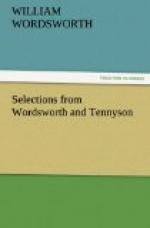27-28. ‘HE BURNT—SOME TWELVE BOOKS.’ This must not be taken literally. See, however, p. xxxiii. of the Biographical Sketch, as to Tennyson’s hesitation in treating the subject.
48-51. This is self-portraiture. Lord Tennyson’s method of reading was impressive though peculiar.
MORTE D’ARTHUR
THE ARTHURIAN LEGEND. Throughout the mediaeval period three great cycles of stories commanded the imagination of the poets. Of these cycles one, the tale of Troy in its curious mediaeval guise, attested the potent spell of antique legend.[1] The two other great cycles were of later origin, and centred around the commanding historical figures of Charlemagne, and the phantom glory of the legendary Arthur.
[1]The extraordinary interest in the half legendary career of Alexander the Great must be noticed here, as also the profound respect amounting to veneration for the Roman poet, Vergil.
The origin of the Arthurian story is involved in obscurity. The crudest form of the myth has doubtless a core of historic truth, and represents him as a mighty Celtic warrior, who works havoc among the heathen Saxon invaders. Accretions naturally are added, and a miraculous origin and a mysterious death throw a superstitious halo around the hero. When the brilliant personality of Lancelot breaks into the tale, and the legend of the Holy Grail is superadded, the theme exercised an irresistible fascination upon the imagination of mediaeval Europe.
The vicissitudes of the Celtic inhabitants of Britain are as romantic as any of which history holds record. After the departure of the Roman invaders from the island, the native population swiftly reasserted itself. The Picts of Caledonia and the Scots of Ireland were their natural foes, but conflict with these enemies served only to stimulate the national life. But actual disaster threatened them when in the fifth and sixth centuries the heathen Angles and Saxons bore down in devastating hordes upon the land. It is at this critical period in the national history that Arthur must have lived. How long or how valiant the resistance was we cannot know. That it was vain is certain. A large body of Britons fled from annihilation across the channel, and founded in the region of Armurica in France, a new Brittany. Meanwhile, in the older Britain, the foe pressed hard upon their fellow-countrymen, and drove them into the western limits of the island, into the fastnesses of Wales, and the rocky parts of Cornwall. Here, and in Northern France, proud in their defeat and tenacious of the instincts of their race, they lived and still live, in the imaginative memories of the past. For them the future held little store of earthly gain, and yet they made the whole world their debtor.
Even in the courts of the conqueror Saxon their strange and beautiful poetry won favour, and in a later century the Norman kings and barons welcomed eagerly the wandering minstrels from Brittany and Wales. But it was not from these scattered sources that Celtic traditions became a European possession, as a brief statement of literary history will clearly show.




